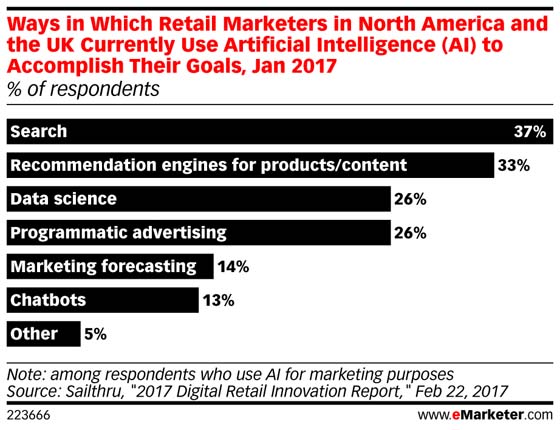Tapping virtual assistants and chatbots
Voice-assisted commerce is likely to be the next frontier for retailers.
Rising comfort levels with virtual assistants and chatbots, as well as advances in technology, voice commands and messaging apps are presenting new sales platforms.
“A shift has begun from consumer usage of websites to platforms like messaging apps and connected devices, so retailers and brands are trying to follow them there—and exploring the possibilities of using these channels for digital commerce,” said eMarketer analyst Krista Garcia, the author of a new eMarketer report, “Conversational Commerce 2017: Chatbots and Virtual Assistants.” (The full report is available only to eMarketer PRO subscribers).
Listen In: eMarketer’s Krista Garcia and Victoria Petrock discuss the impact of virtual assistants and chatbots on ecommerce.
At its most basic, conversational commerce represents the intersection of messaging apps and virtual assistants with shopping.
On the surface, voice-enabled speakers and chatbots might not seem that similar, despite both platforms harnessing AI and some degree of natural language processing, but in many ways both have the potential for added convenience, speeding up customer service interactions and removing friction from sales conversion.
“Mobile shopping remains clunky, and apps have only been a partial solution,” said Garcia. “Consumers tend to use the same few, and often don’t even open the ones they do download.”
Conversational commerce has begun to emerge as a way to combat app fatigue and bring shopping to where consumers are spending more time—in chat apps, and interacting with digital assistants like Siri.
This potential audience remains small, though, and conversational commerce has yet to see mass adoption from digital marketers.
According to Sailthru, among retail marketers in North America and the UK who use AI, few were using chatbots to accomplish their goals in January 2017. More traditional marketing tactics like search (37%) and recommendation engines (33%) took precedence.

Similarly, chatbots and virtual agents ranked last for planned spending increases among information and communication technologies decision-makers worldwide surveyed in Q4 2016 by Ovum. Though at close to half (48.6%) of respondents, the proportion isn’t insignificant.
Marketers’ views on their future use of chatbots and virtual assistants appear cautiously optimistic. Justin Marshall, vice president of emerging media partnerships at digital agency Possible, considers chatbots a bit of a gimmick—at least until the technology and customer experience improve enough to justify investments. “You’ll start to see that consumers not only view [chatbots] as an expectation, but brands also need to meet that expectation,” he said.

